
Women in the Armed Forces: WACs, WAVES, USMC Women's Reserve, and SPARs
During the war years between the 13 and 14 million Americans served in uniform, more than ten percent of the total population at the outbreak of the war. The strain on American resources during the war years was enormous. Initially the draft eligible age range for men was 20 to 44, but later in the war the lower number was reduced to 18 while upper age limit was reduced to 37. Men in occupations related to the war effort, such as aircraft, motorized vehicle or weapons or weapons production and farming effort were excused. Production of food and military equipment was deemed to be just as important as serving in the military. (During the course of the war, almost 30% of all military equipment used by the Allies was produced in the United States.)
Early in the war it was called to General Marshall's attention that thousands of men were being trained to do clerical jobs such as typing, filing, and other administrative duties. Aides pointed out to the Chief of Staff that tens of thousands of American women were already adept at those jobs. It made no sense not to use their skills so that more male soldiers could be used in combat roles. General Marshall directed the military services to make provisions for accepting women into the active ranks. By the time the war was over almost 400,000 women had served in uniform in a variety of capacities both in the States and overseas, many of them in combat zones.
The Army authorized the Women's Army Auxiliary Corps (WAAC) in 1942. In 1943 the group was renamed the Women's Army Corps (WAC) and was integrated into the regular Army. Oveta Culp Hobby, a well-known Texas political figure and wife of a former governor of Texas, was named the first director of the 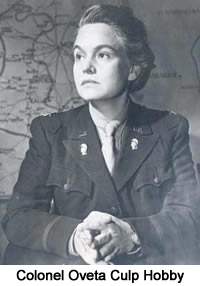 Women's Army Corps with the rank of colonel. She was later awarded the Distinguished Service Medal for her service, the first woman to receive that honor. Early in 1942 Colonel Hobby was visiting a graduating class of about 500 enlisted women who were graduating completing an Army training course in clerical skills. After the ceremony she addressed the women, telling them that there was an excellent chance that they would be sent overseas and might be subject to hostile fire. (Plans for the landings in North Africa were underway.) She told the women to think it over until morning, consult their families, and assured them that they would be excused from going without prejudice. The sergeant major in charge of the class told the colonel forthwith that they would all be willing to go, which Colonel Hobby quickly confirmed.
Women's Army Corps with the rank of colonel. She was later awarded the Distinguished Service Medal for her service, the first woman to receive that honor. Early in 1942 Colonel Hobby was visiting a graduating class of about 500 enlisted women who were graduating completing an Army training course in clerical skills. After the ceremony she addressed the women, telling them that there was an excellent chance that they would be sent overseas and might be subject to hostile fire. (Plans for the landings in North Africa were underway.) She told the women to think it over until morning, consult their families, and assured them that they would be excused from going without prejudice. The sergeant major in charge of the class told the colonel forthwith that they would all be willing to go, which Colonel Hobby quickly confirmed.
The Coast Guard began enlisting women to administrative and secretarial positions in 1941. The Coast Guard establishment for women was known as the SPARS, based on the Coast Guard motto Semper Paratus, Always Prepared. The commander of the spars was Lieutenant Commander Dorothy C Stratton, a former WAVE officer and former Dean of Women at Purdue University. SPAR officers and enlisted women accepted contracts for service until the war ended plus six months. SPAR officers were trained at the United States Coast Guard Academy in New London, Connecticut. Enlisted women were initially trained in Palm Beach Florida, but the training facility was later moved to Brooklyn, New York. For the first part of the war SPARs served only in the continental United States, but in 1944 it became possible for them to serve in the Hawaiian Islands or Alaska.
Recruiting wound for the SPARs in competition with the other services was challenging. Two of the recruiting officers reported after the war that their recruiting efforts included appearing on the radio, making speeches in movie theaters, leading parades, manning information booths at fairs and other outdoor events. They claimed that they struggled and prayed to make their quotas. During the course of the war about 11,000 women served their country in the Coast Guard. At first the SPARS accepted only white applicants, but later in the war they also enlisted a small number of African-American women. Their training included mostly administrative kinds of duties including correspondence, personnel management and other organizational duties.
A number of the women were trained iIn other than administrative areas as communications and supply officers, but a selected number of officers and enlisted SPARS were trained to work with the top-secret LORAN navigation program, used to guide both ships and aircraft, and they later manned LORAN stations around the country. Other duties aside from administrative jobs included food service, driving Coast Guard vehicles, rigging parachutes and other billets. Even women in boring jobs felt satisfied that they were serving their country, thus allowing male members to conduct combat related missions. As was true and the other services, there was a certain resistance among the male members to women in the Coast Guard, but they eventually began to recognize their merit.
Following the war the former Commodore of the Coast Guard praised the SPARs highly for their service. He said they did their jobs professionally and with enthusiasm and claimed that the Coast Guard was fortunate to have their service in time of war. Later the Coast Guard named two of its cutters in honor of the SPARS, both name USCGC Spar.
In 1942 the Navy began recruiting women into the Women Accepted for Volunteer Emergency Service (WAVES). During the course of the 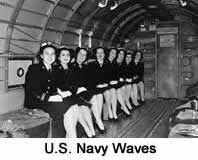 war over 80,000 WAVES performed tasks in administration, communication, supply, medicine, intelligence and in other positions. The Navy Nurse Corps also had over 14,000 women who served as nurses on hospital ships overseas and as flight nurses. Some of those nurses found themselves in contact with the Japanese enemy. In the Philippines, 11 Navy nurses were captured by the Japanese and imprisoned for 37 months. Following the capture of Guam, five of the Navy nurses on that island were imprisoned by Japanese and held as prisoners for five months before being exchanged.
war over 80,000 WAVES performed tasks in administration, communication, supply, medicine, intelligence and in other positions. The Navy Nurse Corps also had over 14,000 women who served as nurses on hospital ships overseas and as flight nurses. Some of those nurses found themselves in contact with the Japanese enemy. In the Philippines, 11 Navy nurses were captured by the Japanese and imprisoned for 37 months. Following the capture of Guam, five of the Navy nurses on that island were imprisoned by Japanese and held as prisoners for five months before being exchanged.
In 1943 Congress authorized the Marine Corps Women's Reserve (MCWR) to free male Marines for combat duty in the Pacific. Women Marines served mostly stateside in administrative positions, as cooks, mechanics, vehicle operators and in other positions. When the war ended, 85% of the Marine serving at the Headquarters of the Marine Corps were women. The US Public health service also trained over 100,000 women in the Cadet Nurse Corps for use in the military and its necessary. They provided 80% of all nursing care in hospitals in the United States.
During the course of the war close to 400,000 American women served in the armed forces and between 400 and 500 lost their lives, 16 of those coming from hostile fire. General Marshall decided not to use women in combat, because he was convinced that the American public would not agree with the policy. Following the war women in uniform were accepted as a permanent part of the United States Armed Forces.
The most famous group of women who served during World War II were the Women Airforce Service Pilots, or WASPs. They were actually civilians who were used to fly replacement aircraft overseas when more male pilots were needed in combat roles. Two similar groupswere formes to fly airplanes within United States, 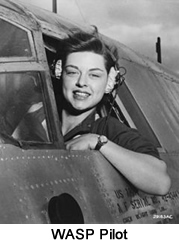 but eventually the WASPs flew airplanes between bases in America and airfields overseas. During the war the 1,074 WASP pilots operated from 126 different locations in the United States and
but eventually the WASPs flew airplanes between bases in America and airfields overseas. During the war the 1,074 WASP pilots operated from 126 different locations in the United States and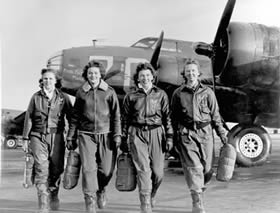 flew a large proportion of combat aircraft of 78 different types, including fighters and B-17 bombers. They delivered a total of 12,650 aircraft. When the first B-17G, an upgraded version of the aircraft, landed at a United States air base in England, pilots were stunned when the crew that emerged from the plane, like the group shown on the right, were all female. In the states the WASP pilots also piloted target-towing planes for live anti-aircraft artillery practice, simulated strafing missions, and transported cargo.
flew a large proportion of combat aircraft of 78 different types, including fighters and B-17 bombers. They delivered a total of 12,650 aircraft. When the first B-17G, an upgraded version of the aircraft, landed at a United States air base in England, pilots were stunned when the crew that emerged from the plane, like the group shown on the right, were all female. In the states the WASP pilots also piloted target-towing planes for live anti-aircraft artillery practice, simulated strafing missions, and transported cargo.
Women were also valuable in intelligence services serving in the Office of Strategic Services, or OSS. They made up one third of all OSS employees. They served in a variety of capacities, including administrative positions as well as operating agents, codebreakers and in undercover positions. A total of 1,500 women in the OSS served overseas. A woman spy named Elizabeth Pack was instrumental in procuring a German enigma machine from Polish intelligence services. She also helped to capture a tie and in French codebooks. A spy named Virginia Hall reported on Sherman operations in France and was claimed by the Gestapo to be one of the most dangerous spies working against them.
More than 1,600 nurses were decorated for bravery under fire and meritorious service, and 565 WACs in the Pacific Theater won combat decorations. Nurses were in Normandy on D-Day plus-4. Sixteen women were killed by enemy action. Several hundred were killed in accidents with aircraft or military machinery and equipment.
Women in Civilian Work During the War
Needless to say, women were urgently needed in a variety of civilian positions at home. The most famous symbol of those women was Rosie the Riveter, but women worked in a wide variety of jobs, many of which few women had ever engaged in before. They worked in factories building heavy military equipment, 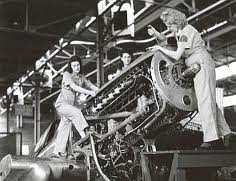 drove trucks, plowed farm fields and harvested crops, and did virtually every known clerical job. Nearly 1,000,000 women came to Washington to work for the United States government, and they became known as the "government girls." Women grew crops in victory gardens, worked in food production plants, donated blood and sold war bonds. Being aware that silk was needed for parachutes, they gave up wearing silk stockings and instead put makeup on their legs and drew seams in back with eyebrow pencils to look like sas if they were wearing stockings. The government also encouraged women to avoid sending "Dear John" letters to soldiers overseas, for fear of undermining troop morale. A popular song at the time was "They're Either Too Young or Too Old," suggesting that husbands need not worry about their wives because all the available young men were already in the Army.
drove trucks, plowed farm fields and harvested crops, and did virtually every known clerical job. Nearly 1,000,000 women came to Washington to work for the United States government, and they became known as the "government girls." Women grew crops in victory gardens, worked in food production plants, donated blood and sold war bonds. Being aware that silk was needed for parachutes, they gave up wearing silk stockings and instead put makeup on their legs and drew seams in back with eyebrow pencils to look like sas if they were wearing stockings. The government also encouraged women to avoid sending "Dear John" letters to soldiers overseas, for fear of undermining troop morale. A popular song at the time was "They're Either Too Young or Too Old," suggesting that husbands need not worry about their wives because all the available young men were already in the Army.
Among the more important jobs women performed was their work in the aviation industry. Women worked building to B-29 the super fortresses that would eventually deliver the atomic bomb on Japan. They had to be specially configured to accommdate "fat man" and "little boy," the actual bombs that were dropped. One senior executive of an aircraft company announced to the press that women were designing aircraft in engineering divisions and building them on the production line, where they used every conceivable type of machinery from "rivet guns to giant stamp presses." Women also proved to be more skillful than men in certain jobs requiring meticulous attention to detail, such as drilling holes in aircraft bodies. They also proved to be very inefficient safety inspectors in all kinds of jobs, including inspecting planes coming off the assembly line.
Naturally, as in the armed forces, there was resistance in the male population two women moving into what were considered to be jobs for men only. Many managers were skeptical about the ability of women to do hard, laborious jobs, such as working with heavy equipment and production tools. One example was of an African-American woman who arrived at a factory to apply for a job as a riveter, which she had seen advertised. The manager told her that they had filled their need for riveter's, and all he needed now was welders. The woman replied, "I can do that," and the manager led her into a shop, pointed to some pieces of metal and welding equipment on a tool bench and told her to have at it. Within minutes she had fired up the welding torch, put on the mask, and did a neat job of welding the pieces of metal together. She was hired on the spot.
In the end there seem to be no limit to what women could accomplish when they set their minds to it, and in the environment of a world war, they did exactly that, for the most part without complaining and even excepting salaries that were not equal to their fellow male workers. With father's brothers and husbands in service overseas, many women grew tired of sitting around the house and were happy for any kind of work. The country was more than ready to employ them, and their contribution to the war effort was enormous.
Resources for Women in World War 2
| Sage History Home | World War 2 Home | Home Front | Updated May 1, 2017 |